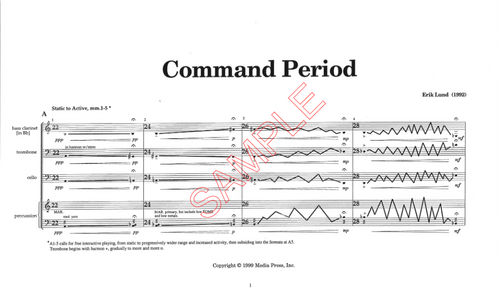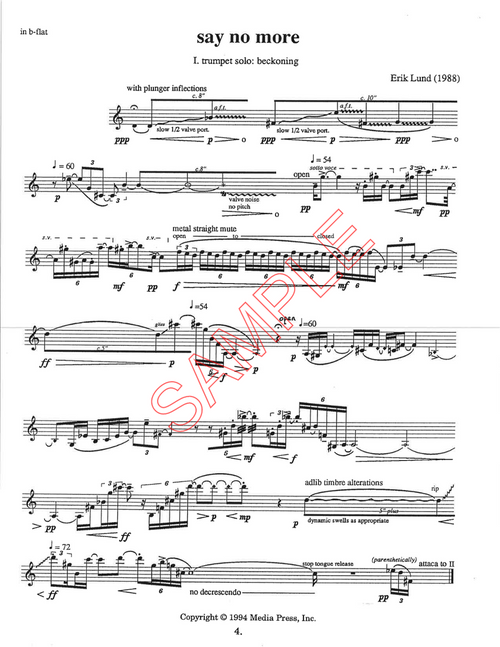For bass clarinet, trombone, cello and percussion, includes score and parts. Command period explores the combination of notated and improvised musics, where the ensemble renders a written composition with windows of improvisational opportunities. The work can be played from score, without a conductor - or - from parts, with a conductor. Duration: ca. 13 minutes
Want it now? Click here to purchase a digital copy of this product.
Review from Percussive Notes (2022):
Command Period
Erik Lund
This mixed quartet is an incredibly intricate work that mixes improvisation with strictly notated music. First performed in 1993, it requires players with great facility on their instruments, the stamina to play for a long period while switching between improvisation and notation at a moment’s notice, and the musical maturity to make the improvisation be the background, not the fore.
The piece has sections of three types: mostly composed music, group improvisation, and composed music underscored by improvisation. The first major portion of the work is of the mostly composed category. The music here is constructed entirely of sixteenth-note rhythms of varying grouping size — meaning there are several complex time signatures used. The melodic gestures sweep up and down the ranges of all the instruments, which would give the impression that they are improvising were it not for the rhythmic unison gestures and the apparent interplay between the players. This trend gradually morphs into a section of group improvisation, where the only instructions are a series of descriptors, such as “confusion,” “combativeness,” and “assured.”
The piece emerges from this chaotic spree into the section that equally combines notation and free improvisation. The individual players do not get much reprieve here, since most of the time, when they do not have a written line, they are instructed to improvise. Besides the stamina required to perform in this way, there is the musical challenge of making sure the unwritten notes do not over-balance the composed lines. The piece ends with short bursts of notated gestures, followed by several clusters of improvised blocks that gradually diminish into nothing.
The percussionist for this piece plays from four different setups: the marimba, the set of three cymbals, the set of three toms, and the “Timbre Rack,” which is the combination of woods, glasses, and metals. The score offers a different notation for each of these setups, which is helpful to the performer, as some of the transitions are rather quick. The percussionist also needs to prepare for several rapid switches between playing with mallets in the appropriate manner and playing with the handles.
This composition will undoubtedly yield an intriguing performance from any group that decides to take it on. Although the program notes state that it can be performed with a conductor, it is recommended that it be done unconducted by professional players. This will eliminate any confusion that conducting the complex time signatures would create, and it will also make the conversational and confrontational elements that the composer skillfully weaved into the work more noticeable.
—Kyle Cherwinski







